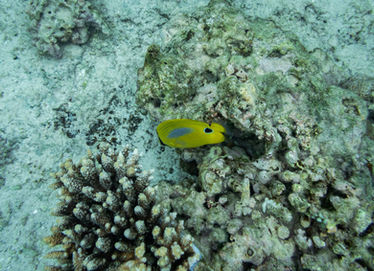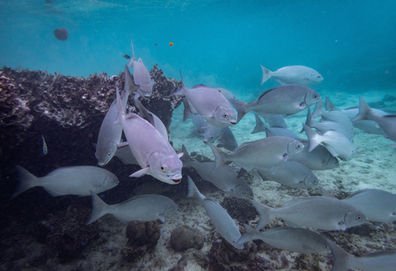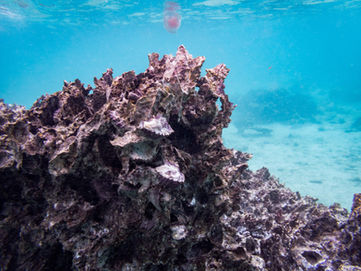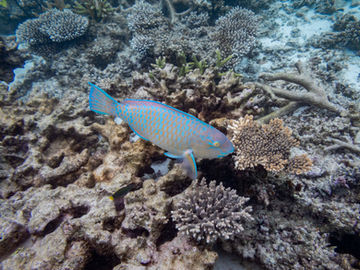
Oyster Stacks
Ningaloo Reef
Start - Yardie Creek Road
Trail Type - Snorkel
Length - 1.0km (Explore)
Depth - 1-3m
Time - 1 Hour
Date Snorkeled - 6th August 2021
Directions - Located about 65km from Exmouth, head north out of town on Murat Road and take a left onto Yardie Creek Road. Follow the signs for Cape Range National Park and keeping driving until you see the turnoff for Oyster Stacks on your right. Turn here and follow the road until you reach the carpark. Entry into the water is off a rocky platform so care must be taken when the conditions are a bit choppy.
The Snorkel - Exmouth had treated us pretty well weather wise for the first half of our weeklong trip but things weren't looking so great for the last few days. I still had two snorkeling sites I wanted to check out while we were here and the Saturday morning was really the best it was going to get. Oyster Stacks is one of the only spots that is really tide dependent and to make sure you aren't bashing into the coral reef, it's best to do this at high tide. This was our penultimate day in Exmouth and I wanted to get in at least one more snorkel while I had the opportunity.
With the tide being best during the middle of the morning to just after midday, we had a long breakfast before driving out along what was now a very familiar road into Cape Range National Park. I knew from our previous day snorkeling at Turquoise Bay that the jellyfish were here in force but was kind of hoping Oyster Stacks was going to be sheltered from these drifting menaces. We could see the clouds rolling in slowly as we arrived at the car park but the good part was that the wind was not as fierce as it had been for the earlier part of the week. Oyster Stacks is different from a lot of the other snorkeling spots because there is no direct beach access from the car park, instead you enter the water via a rocky ledge that can be tricky if the swell is up. It also means that there is no easing into the water, just a quick plunge and you're straight into the action. Caris elected not to do this one so stayed with the gear but Candy and Hal had come with us as they hadn't done much snorkeling this trip. I was first in the water while Candy and Hal faffed and was excited to see what I would find here after spotting some excellent marine life at Turquoise Bay and Lakeside.
The name Oyster Stacks refers to exactly that, a series of rocky formations where over time the oysters have stacked on each other to create this sharp and solid structure. From where the path heads down from the car park there are a series of them heading south and depending on the tide, you might see a couple poking their head above water. The best way to see them is to follow one side heading south and then head back north on the other side. Along with the Oyster Stacks there is some great coral reef here extending out to the west and I deviated between that and the stacks depending on what marine life I saw. Heading out to the first of the Oyster Stacks, this snorkel would be a case of avoiding the jellyfish at all costs (they do sting), something that was quite difficult at times due to the sheer number of them and the currents around the Oyster Stacks. Early on I spotted a large school of either Bream or Drummers that to me seem to be the happiest fish in the world as most photos always have a few of them smiling brightly at the camera. I was pleased to see that the fish like to attack the jellyfish as I'm not a big fan of them either, with the Threadfin Butterflyfish really getting stuck in.
There were still two underwater creatures I had been wanting to see while I was up here, a starfish and a nudibranch, with both eluding me so far. It was a nice moment when I spotted a black starfish in the sands between coral reef and would be the first of a few I would see here including a bright blue chonka that looked pretty cool. Hal had caught up to me as I explored one of the Oyster Stacks and it was a bit of a task to try and get close enough for photos but also avoid the surging water that could push you into the sharp edges. While there was a bit of life hanging around these formations, I found them to be a bit barren compared to the nearby reef as they don't provide much shelter for the smaller fish and the lack of coral to eat means the Parrotfish don't visit. They are still quite cool to check out but for the most part I headed out over the coral reef to the west and between the stacks. Here the fish were plentiful with many different kinds including colourful Wrasse, Parrotfish, Convict Surgeonfish, Harlequin Filefish, Hawaiian Triggerfish, Long Toms, Banded Humbugs, Blue Angelfish, Threespot Rabbitfish and juvenile Black Damsels (which are actually white, yellow and blue).
Switching between the various Oyster Stacks and the coral reef provided good variety and something new to explore. While I hadn't seen a nudibranch at all, I did see something flapping on the underside of a piece of coral that I assumed was a random bit of jellyfish that had been caught on a sharp edge. Turns out this was a nudibranch egg deposit so that was kind of cool. Another nice find while I was exploring the coral reef was the tail of a Blue Spotted Ray that had taken refuge under a ledge. I waited above for it to come out but it was quite happy having a rest there and I only got to see the beautiful colouring on the tail section that was sticking out. Reaching the final Oyster Stack, there was a blue starfish in one of the crevices that looked a bit worse for wear and I wonder if it ventured up here and then found out it wasn't the best area to live. With nothing left to do but swim back to the start, I explored the sandy patches between the Oyster Stacks and the rocky platform to see if there was anything interesting there I hadn't seen yet. The other were already out of the water so I joined them as we still had one more spot I wanted to check out. Driving down the road to Pilgramunna Ledges, this turned out to be a bit of a dud when we were there thanks to a lot more jellyfish in the water and visibility akin to a bad day in Perth. To top it off I got stung on the back of the leg by a jellyfish so this will have to be one I explore on our return visit in 2022.
Final Thoughts - Oyster Stacks provides something a bit different to the usual coral reef exploration and it was fascinating to see the formations up close.
Unfortunately conditions on our visit weren't great but we made the most of it and still saw a great variety of marine life.
This is definitely a must snorkel spot if you're visiting the area and the section north of the Oyster Stacks is also worth exploring if you have the time and nice conditions.
I look forward to coming back here in better weather as it really is a great spot to explore.
Get out there and experience it!
Be sure to tag any Oyster Stacks photos on Instagram with #thelifeofpy and if you enjoyed this hike then feel free to share this page on Facebook with your friends.
If you've found this page or the website helpful and you want to show your support then consider making a small donation by visiting our Ko-fi page. You can give as little as a dollar with no sign-up required and everything will be put towards the website, creating new content and promoting the trail community.






























































